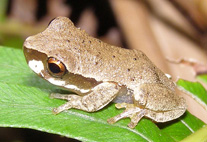Abstract
The Litoria phyllochroa species-group are small hylid frogs that occur in wet forests of south-east Australia. This group has had a long history of taxonomic confusion and has received little attention in the last decade. A population of this species-group at Kroombit Tops, several hundred kilometers north of all other populations, has been recognised for some time as being genetically highly distinct. Here we describe this population as a new species, L. kroombitensis sp. nov. This species is most similar to L. barringtonensis and L. pearsoniana but is readily distinguished based on differences in mor-phology, colour pattern, mating call and genetics. Litoria kroombitensis sp. nov. is restricted to Kroombit Tops, an isolated area of wet forest in south-east Queensland. The species inhabits slow and intermittently flowing streams in rainforest and adjoining wet sclerophyll forest. The tadpole of L. kroombitensis sp. nov., described herein, is similar in morphology and behaviour to the tadpoles of other species within the Litoria phyllochroa species-group, in particular L. pearsoniana. Li-toria kroombitensis sp. nov. has a very small distribution, with all records coming from the headwaters of five streams. Extensive surveys since the mid-1990s have revealed population declines, attributable to amphibian chytrid fungus (Batrachochytrium dendrobatidis). Other threats include degradation of riparian habitat due to invasive weeds, feral pigs and livestock, and fire. Further, the extent of wet forest habitats at Kroombit Tops is likely to be reduced by climate change impacts. Litoria kroombitensis sp. nov. meets IUCN Red List criteria for critically endangered CR B1ab (i–v) due to its small geographic range, naturally fragmented distribution, and observed and projected decline in populations. In this paper we also assess the validity of the names L. barringtonensis, L. pearsoniana and L. piperata. We conclude that the names L. barringtonensis and L. pearsoniana are valid but the validity of L. piperata requires further investigation.

